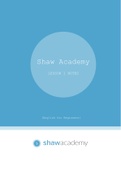Class notes
Teacher's notes of English diploma for Academic purposes (part1,4)
- Institution
- English For Academic Purposes
This is part 1-4 of general English diploma which are very handy for anyone learning general English. It covers everything about Parts of speech, Tenses, Verbs, Active passive voice, quantifiers and much more. The aim of this course is to help you feel at ease and operate confidently in an Englis...
[Show more]



